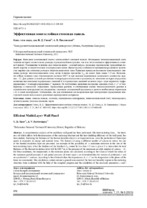| dc.contributor.author | Сизов, В. Д. | |
| dc.contributor.author | Павловская, А. В. | |
| dc.coverage.spatial | Минск | ru |
| dc.date.accessioned | 2022-11-11T11:06:42Z | |
| dc.date.available | 2022-11-11T11:06:42Z | |
| dc.date.issued | 2022 | |
| dc.identifier.citation | Сизов, В. Д. Эффективная многослойная стеновая панель = Efficient Multi-Layer Wall Panel / В. Д. Сизов, А. В. Павловская // Наука и техника. – 2022. – № 5. – С. 410-418. | ru |
| dc.identifier.uri | https://rep.bntu.by/handle/data/122354 | |
| dc.description.abstract | Выполнен комплексный анализ многослойной стеновой панели. Исследован теплоизоляционный слой, толщина которого влияет как на размеры ограждающей конструкции, так и на теплозащитную эффективность стеновой панели. Уменьшение толщины слоя теплоизоляции – важный вопрос, поскольку производство трехслойных панелей затратно в энергетическом и материальном плане. Представлены особенности применения различного количества экранов для снижения размеров теплоизоляционного слоя. Приведен пример возможности максимального снижения размера теплоизоляционного слоя, когда толщина прослойки не может быть менее 3–5 мм. Показано, что общая толщина слоя теплоизоляции составит 0,057 м при наличии максимально возможного количества экранов – 12. Для данных условий рассчитаны температуры в плоскостях ограждения, по значениям которых определены величины максимальных парциальных давлений Е и парциальных давлений водяного пара е (при вариантах перфорированных е' и неперфорированных е'' экранов). По полученным значениям построены зависимости E, е', е'' от температуры в плоскостях ограждения. Проведенные расчеты и обобщающая оценка тепловлажностного режима в ограждающих конструкциях подтверждены с помощью составленной программы и расчета необходимых параметров е и t в слоях конструкции. Установлено, что для исключения зон конденсации при эксплуатации ограждающих конструкций можно использовать различные экранирующие материалы. | ru |
| dc.language.iso | ru | ru |
| dc.publisher | БНТУ | ru |
| dc.title | Эффективная многослойная стеновая панель | ru |
| dc.title.alternative | Efficient Multi-Layer Wall Panel | ru |
| dc.type | Article | ru |
| dc.identifier.doi | 10.21122/2227-1031-2022-21-5-410-418 | |
| local.description.annotation | A comprehensive analysis of the multilayer wall panel has been performed. The heat-insulating layer, the thickness of which affects both the dimensions of the enclosing structure and the heat-shielding efficiency of the wall panel, has been studied. Reducing the thickness of the thermal insulation layer is an important issue, since the production of three-layer panels is expensive in energy and material terms. The features of using a different number of screens to reduce the size of the thermal insulation layer are presented. An example of the possibility of a maximum reduction in the size of the heat-insulating layer, when the thickness of the interlayer cannot be less than 3–5 mm is given. It is shown that the total thickness of the thermal insulation layer will be 0.057 m in the presence of the maximum possible number of screens – 12. For these conditions, the temperatures in the enclosure planes are calculated, according to the values of which the values of the maximum partial pressures E and partial pressures of water vapor e are determined (for the variants of perforated е' and non-perforated е'' screens). According to the obtained values the dependences E, е', е'' on the temperature in the planes of the fence are constructed. The calculations carried out and a general assessment of the heat and humidity regime in the enclosing structures were confirmed with the help of the compiled program and the calculation of the necessary parameters е and t in the layers of the structure. It has been established that various shielding materials can be used to exclude condensation zones during the operation of enclosing structures. | ru |

